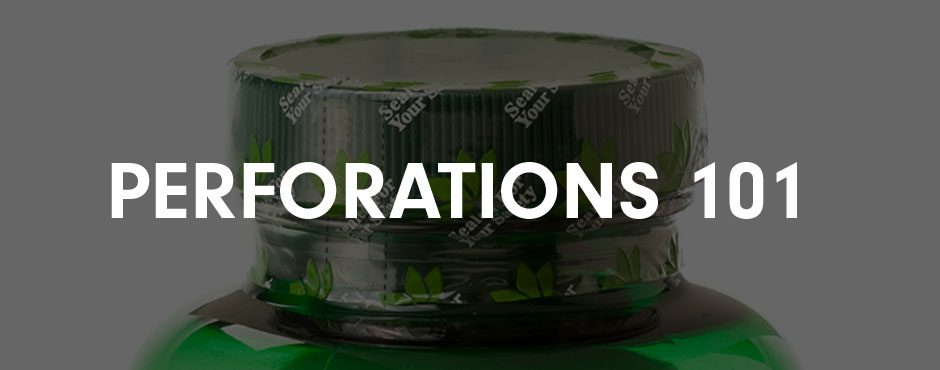
Perforations 101
Perforated film is present in our daily lives more than you may realize. They are seen in a variety of industries, from personal care products and cosmetics, to foods and pharmaceuticals. Perforations on shrink sleeve labels and tamper bands allow the film to contour to the shape of the container and provide an easy way to remove the film when opening or recycling the product. This blog discusses what perforations are along with the benefits of using them.
What are perforations?
Perforations are small holes punched into a substrate, typically paper, plastic, and other packaging products, allowing easy removal. A perforation is created by a blade that looks similar to a wheel. Each blade has several teeth available in various sizes to create the perforation.
Vertical Perforations
Most tamper-evident bands include full vertical perforations. Tamper bands are a type of shrink sleeve label that wrap around the neck of a container and give the product an extra layer of protection. Many products with tamper bands have the added feature of perforations to be easily removed once the consumer purchases the product. Full vertical perforations can also ease the removal of full-body shrink sleeve labels from the container. Perforators can be supplied as an add-on to a shrink label applicator. AFM offers perforators to create perforations on film before it is cut and applied to the container.
Horizontal and Partial Vertical Perforations
If you want to keep the full-body shrink sleeve label in place, a horizontal and partial vertical perforation is the best option. A horizontal perforation is made just below the cap or the closure of the container. When the consumer pulls on the portion above the horizontal perforation, it will remove that piece only, leaving the full-body shrink sleeve label in place. This feature allows for perforations on middle, full-body, and full body and cap applications, making it a versatile feature.
Finding the Right Perforation
It is important to test out the perforations on the film you would like to use. A particular blade might create perforations that are too large for your product, so it’s always a good practice to test and verify that the perforation is a good fit. On neckbands, make sure the perforation is long enough on the tamper band or neck portion of the shrink sleeve while maintaining the security aspect of the tamper band. The vertical perforation must be strong enough to stay intact during transportation and handling but still show when tampering has occurred. If the perforation is too weak, it could break prematurely. Once the container with the perforated shrink sleeve goes through a shrink sleeve tunnel, you will be able to see how it looks and functions.
Perforations in Everyday Life
Perforations aren’t only limited to small, punctured holes. For example, if you have ever purchased a bag of grapes from your local grocery store, you will notice bigger holes in the bags. These are called venting perforations. These allow the product, especially food, to breathe and prevent ballooning and premature aging of the product.
Perforations are also seen in our everyday life. For example, perforations on a paper towel roll help you measure and tear off the right amount that is needed. Small perforations can also be seen on notebook paper, allowing easy and clean paper sheet removal.
Want more information about how tamper-evident bands can secure your products? Head to our blog post Tamper Bands 101 to learn more! You can also learn more about how shrink sleeve labels are the desired choice for making your products stand out on the shelf!
AFM’s knowledgeable team of district sales managers are here to answer your questions and help provide your customers with the security and safety they need for their products.
